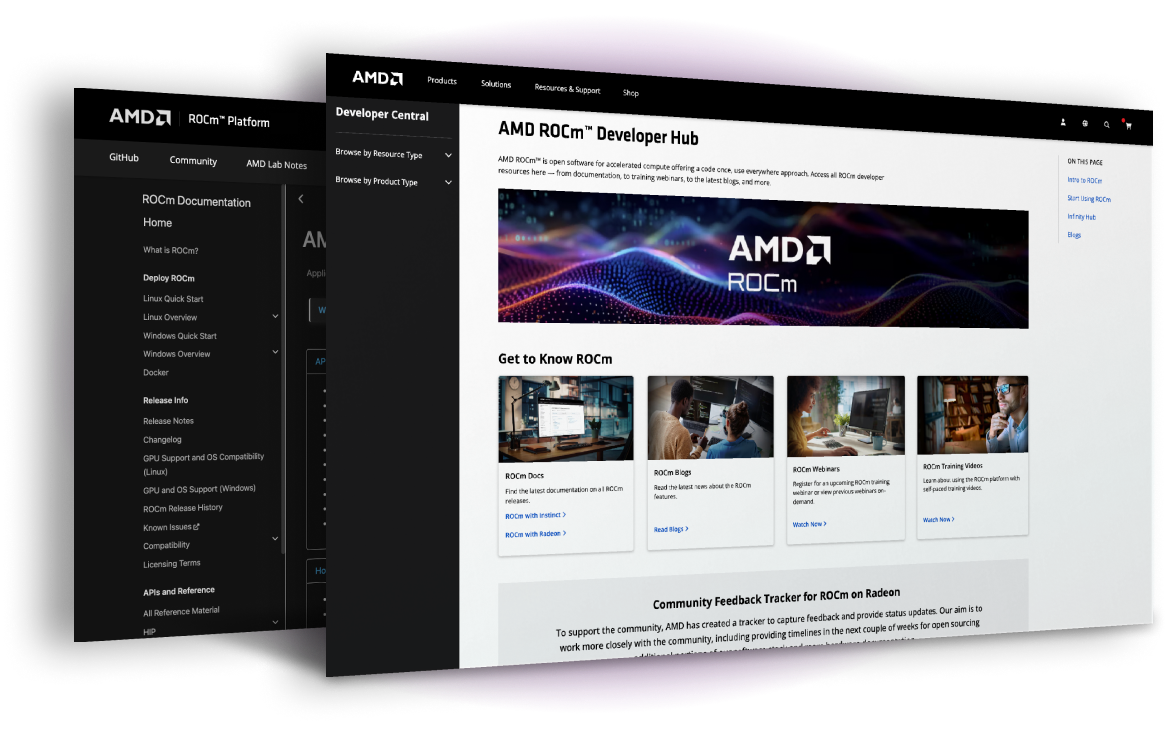ROCm Resources
To deepen your AMD ROCm software understanding, you can access tutorials, videos, and blogs to speed up your test preparation.

Demonstrate your expertise and boost your career by earning an AMD ROCm Star Certificate.

The ROCm™ Star Application Developer Certificate tests your knowledge on developing, optimizing, and deploying AI and HPC applications on AMD hardware using ROCm software.
The 40-question test assesses a developers’ ability to design, refactor, and port applications across diverse hardware configurations, leveraging tools like HIP, OpenMP, and ROCm-accelerated libraries. It also tests knowledge of AMD GPU architecture, including profiling techniques, optimizing for compute units and wavefronts, and measuring performance constraints.
Key skills include configuring build environments, managing library dependencies, and integrating mixed-language software components.
Successful candidates demonstrate the ability to support scientific applications, guide partners on GPU validation, and provide hands-on support for advanced computing environments.


Gain recognition for your technical skills, increase your visibility in the AMD developer community and earn exclusive rewards.

Score 80% and above
Get featured on the AMD ROCm Star Member Page
Earn an exclusive AMD ROCm Star email signature
Receive digital completion certificate

Score 90% and above
Get featured on the AMD ROCm Star Page Member
Earn an exclusive AMD ROCm Gold Star email signature
Receive digital completion certificate
Receive a $50 AMD Developer Cloud (ADC) credit

Score 95% and above
Get featured on the AMD ROCm Star Member Page
Earn an AMD ROCm Platinum Star email signature
Receive digital completion certificate
Receive a $100 AMD Developer Cloud (ADC) credit
Start your journey to becoming an AMD ROCm Star today!


Here are some helpful resources to get you going.
Meet the growing community of developers who have demonstrated hands-on expertise with AMD ROCm™ software and successfully earned their ROCm Star Certificate.


Register to take the test, demonstrate your knowledge on AMD ROCm software.
Participants must be at least 18 years old or of the age of majority in their country/province/state of residence, whichever is older, at the time of registration. Nationals or residents of Belarus, Burma, Cuba, Iran, North Korea, the People’s Republic of China, Russia, Syria, Sudan, Venezuela, or regions under export restrictions are not eligible. Employees of AMD, its subsidiaries, affiliates, and their immediate families are also ineligible
After completing the form, you will get access to a test link within 7 business days.
You will have three chances to take the test with no waiting time between intervals. Note that the test is 40 questions long, however there are multiple versions of the test with 100 available questions and tests will vary.
No. The only instances you may be contacted are if you checked “Yes” to receive marketing emails from AMD or if you checked “Yes” to provide feedback on the testing process.
Your name will only appear on the AMD ROCm Star member page if you checked “Yes” and consented that you would like to be acknowledged. You will have the opportunity to select “Yes” or “No" after the completion of the exam and when your score is shown to you.
No. No one will receive your contact information or contact you for consulting services.
You will receive your ROCm Star certificate, email signature, and an email to set up your AMD Developer Cloud account where your credits will be deposited.
The AMD Developer Cloud (ADC) provides developers and open-source contributors with access to powerful AMD Instinct™ MI300X GPUs through a third-party cloud website. Users can choose between two access options: pay-as-you-go or apply for complimentary hours.
For developers ready to start building on AMD Instinct GPUs immediately, pay-as-you-go access offers a fast and flexible option. Simply create a new third-party cloud, enter your payment information on a secure platform, and begin developing right away.
AMD is offering an initial 25 hours of complimentary cloud credit to qualified developers who apply and are accepted.
For first time credit requests, AMD may provide an initial 25 hours or approximately $50 US worth of cloud credit. The complimentary 25 cloud credit hours for use on AMD Instinct MI300X GPUs on the AMD Developer Cloud may be granted to qualified developers in AMD’s sole discretion. Complimentary credit hours expire ten (10) days from the date of deposit in your developer cloud account unless stated otherwise in your credit confirmation email.
To apply, visit the AMD Developer Cloud to link to a third-party cloud provider’s website and create a new account or log into an existing account to complete the "Request Credit" form. If your request is approved, an initial 25 hours of cloud credit will be added to your account. If the application is denied, you can still access AMD Instinct™ GPUs using the pay-as-you-go option, or you can reapply for credit.
To apply for an initial 25 complimentary credit hours from AMD, follow the instructions above. For questions, reach out to: devcloudrequests@amd.com
The AMD Developer Cloud is intended for independent developers and open-source project contributors involved with ML, low-level programming, and AI applications development.
Cloud credit allocation on the AMD Developer Cloud is determined by AMD in its sole discretion, based on the intended use case (e.g., inference, training, finetuning), and a detailed description of how you plan to use the GPU credit.
You may contact the third-party cloud representative about additional complimentary hours, which may be offered at AMD’s sole discretion or add a valid payment option and pay-as-you-go. You can switch to the production cloud anytime.
Upon application approval, complimentary credits will be deposited in your third-party AMD Developer Cloud account within three (3) business days. Credits will appear on the “My AMD Home” page in the AMD Developer Cloud console.
If you are granted complimentary credit hours for use on Instinct GPUs in the AMD Developer Cloud and your credit expires and you have no active payment method on file, your AMD GPU VM will be destroyed and you will lose access to the GPU(s) and the data on the GPU(s). Similarly, if complimentary credit hours are exhausted, you will lose access to the GPU, any and all data, and the AMD Developer Cloud.
If payment method is added, it will automatically charge your payment method once credit is exhausted.
Complimentary AMD cloud credit applies only to use on AMD Instinct MI300X GPUs. Complimentary credit hours for attached volumes, object storage, or backups, if any, on the AMD Developer Cloud will not be offered. If a GPU Instance is powered off, you are still billed and/or credit hours will apply. Charges are incurred until the instance is destroyed.
When you power off your GPU Instance, you are still billed for it. This is because your disk space, CPU, RAM, and IP address are all reserved, even while powered off. Therefore, charges are made until you destroy the instance.
You own the rights to the work performed on the AMD Developer Cloud. AMD will not acquire the rights to use work done in the AMD Developer Cloud. The AMD Developer Cloud allows you to upload source code, files, software, processes, interfaces, data, text, settings, media, or other information for storage, hosting, or processing by the AMD Developer Cloud (your “Services Content”). You will retain copyright and ownership rights to your Services Content in the AMD Developer Cloud. In addition, except to the extent necessary to provide the cloud products that are made available through the AMD Developer Cloud neither AMD nor any other party will process or use your Services Content for any other purpose without your express written permission.
The AMD Developer Cloud is hosted by a third-party cloud provider. Contact your cloud provider for support here.